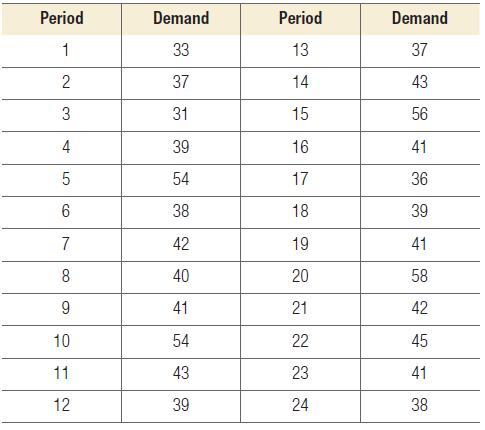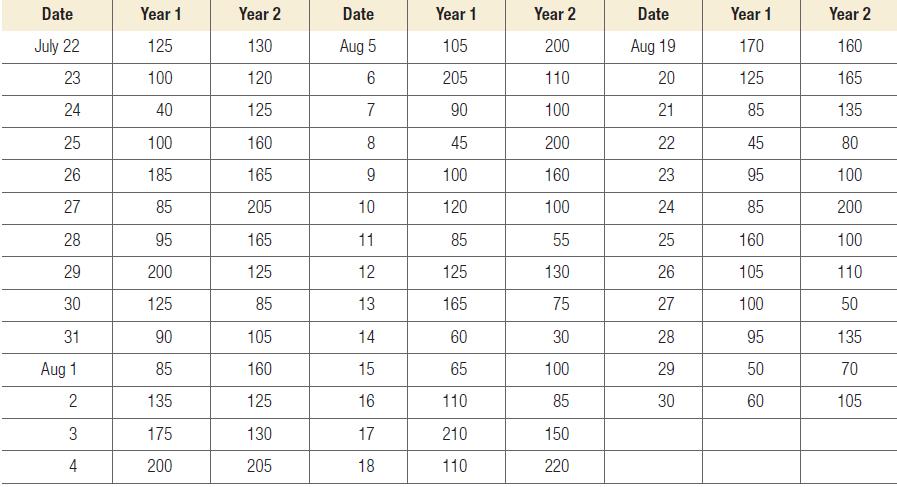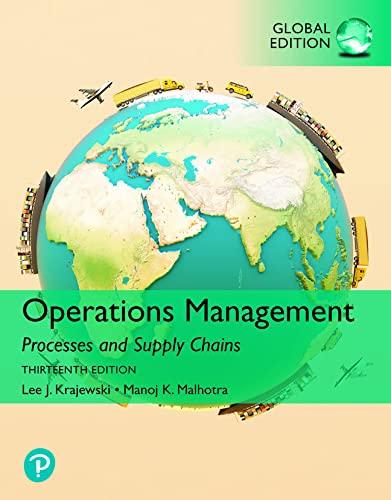A certain food item at P&Q Supermarkets has the demand pattern shown in the following 24-period table.
Question:
A certain food item at P&Q Supermarkets has the demand pattern shown in the following 24-period table.
a. Use the combination forecasting method of the Time Series Forecasting Solver of OM Explorer. Let error analysis begin in month 6, and include (1) a fiveperiod moving average (with a combination weight of 0.33), (2) an exponential smoothing model with
a = 0.20 (with a combination weight of 0.33), and (3) a trend projection (with a combination weight of
0.33). What is the MAD of this model? What is the forecast for month 25?
b. The need to account for seasonality is apparent if you look at a graph of the trend line. There is a spike in demand in the fifth period of each fiveperiod cycle. Unfortunately, OM Explorer's Seasonal Forecasting Solver does not cover the case where there are five periods in a cycle (or seasons in a year). You must do some manual calculations.
Begin by calculating the seasonal factor for each period in each of the first four cycles, and then calculating the average seasonal factor for each period (see Example 8.6). Now estimate the total demand for cycle 5 using OM Explorer's Trend Projection routine in the Time Series Solver. The dependent variables (see "Trend Patterns Using Regression") are the total demands for the first four cycles. Now multiply the average demand estimate for the fifth cycle by the seasonal factor for the fifth period. This is your forecast for month 25. To calculate the errors (including MAD) for the multiplicative seasonal A certain food item at P&Q Supermarkets has the demand pattern shown in the following 24-period table.
a. Use the combination forecasting method of the Time Series Forecasting Solver of OM Explorer. Let error analysis begin in month 6, and include (1) a fiveperiod moving average (with a combination weight of 0.33), (2) an exponential smoothing model with
a = 0.20 (with a combination weight of 0.33), and (3) a trend projection (with a combination weight of
0.33). What is the MAD of this model? What is the forecast for month 25?
b. The need to account for seasonality is apparent if you look at a graph of the trend line. There is a spike in demand in the fifth period of each fiveperiod cycle. Unfortunately, OM Explorer's Seasonal Forecasting Solver does not cover the case where there are five periods in a cycle (or seasons in a year). You must do some manual calculations.
Begin by calculating the seasonal factor for each period in each of the first four cycles, and then calculating the average seasonal factor for each period (see Example 8.6). Now estimate the total demand for cycle 5 using OM Explorer's Trend Projection routine in the Time Series Solver. The dependent variables (see "Trend Patterns Using Regression") are the total demands for the first four cycles. Now multiply the average demand estimate for the fifth cycle by the seasonal factor for the fifth period. This is your forecast for month 25. To calculate the errors (including MAD) for the multiplicative seasonal method for all cycles (except for the fifth month in the fifth cycle), calculate MAD manually. You might instead use the Error Analysis Module of POM for Windows.
c. How do the forecasts by the two methods compare? Which one is likely to give the better forecast, based on MAD?

Step by Step Answer:

Operations Management Processes And Supply Chains
ISBN: 9781292409863
13th Global Edition
Authors: Lee Krajewski, Naresh Malhotra, Larry Ritzman




